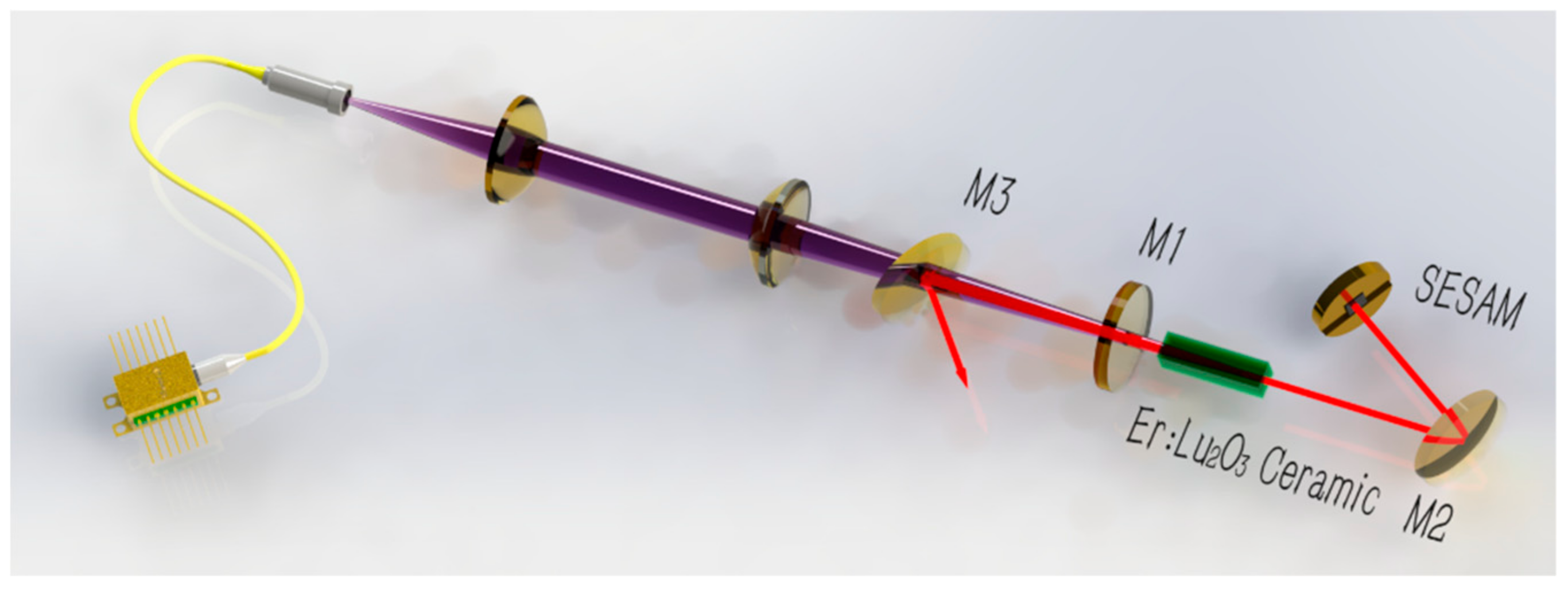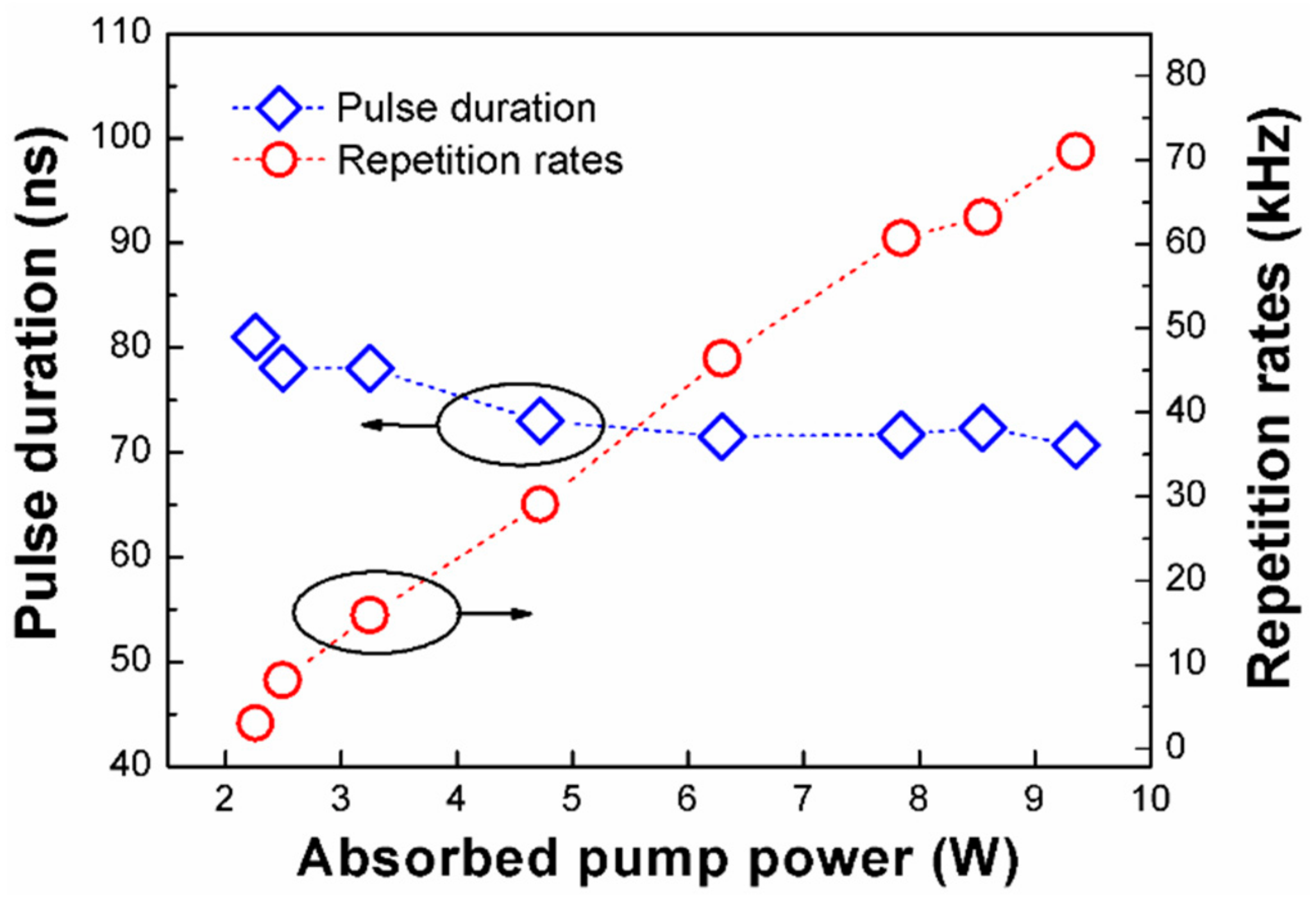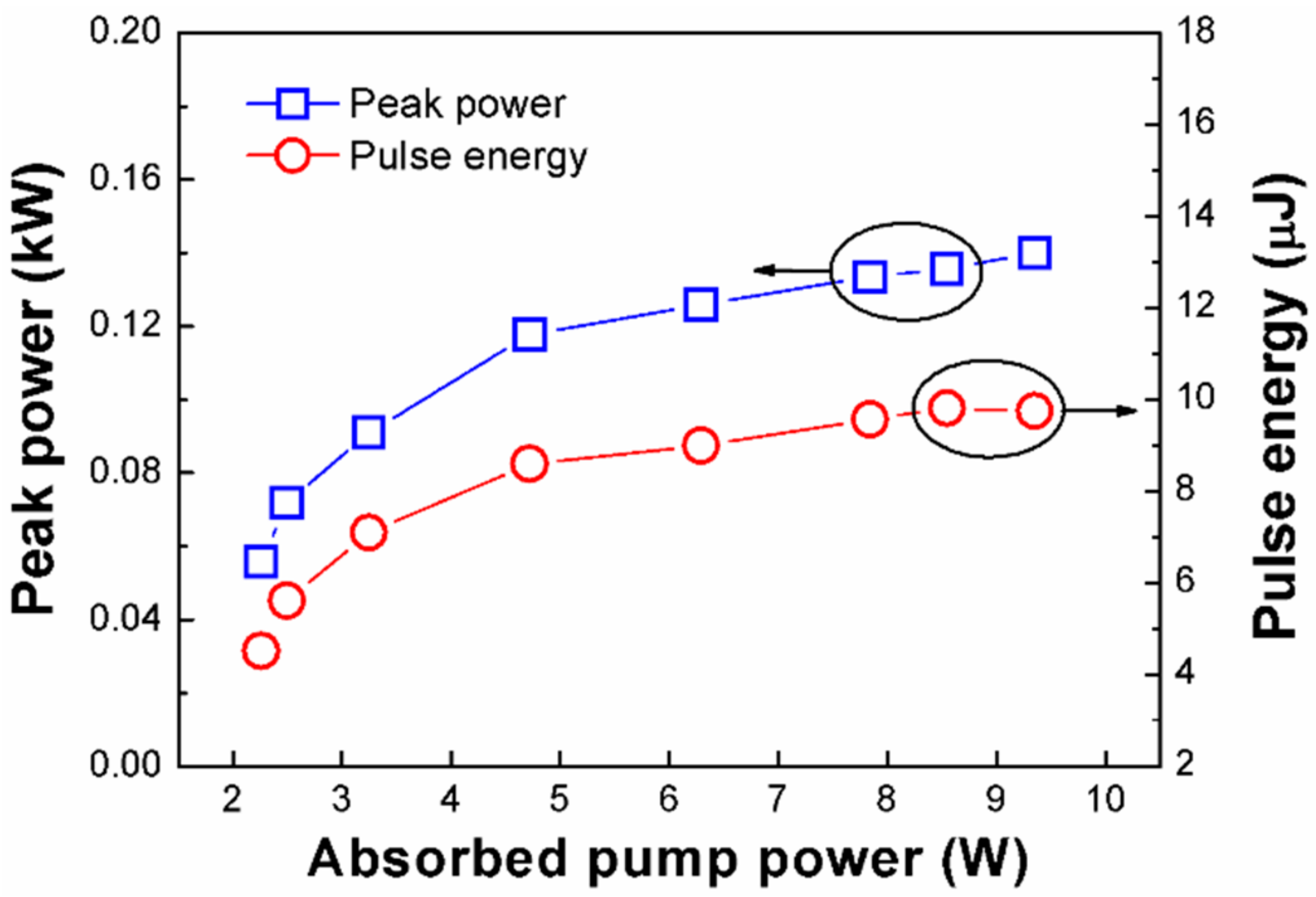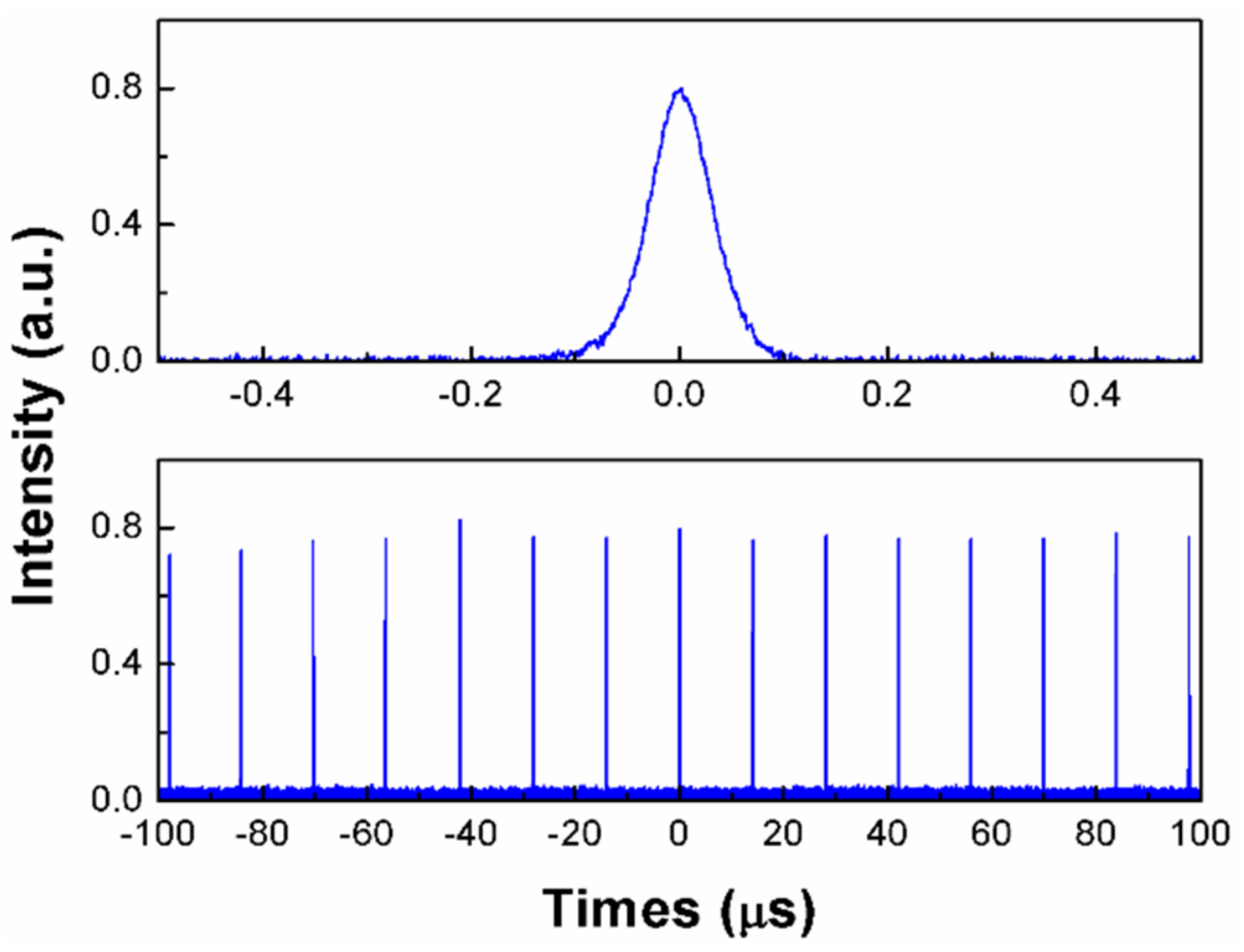High Power and Short Pulse Width Operation of Passively Q-Switched Er:Lu2O3 Ceramic Laser at 2.7 μm
Abstract
:1. Introduction
2. Experimental Details
3. Experimental Results and Discussion
4. Conclusions
Author Contributions
Acknowledgments
Conflicts of Interest
References
- Jackson, S.D. Towards high-power mid-infrared emission from a fibre laser. Nat. Photonics 2012, 6, 423–431. [Google Scholar] [CrossRef]
- Bubb, D.M.; Haglund, R.F. Pulsed Laser Disposition of Thin Films: Applications-Led Growth of Functional Materials, 1st ed.; John Wiley & Sons: New York, NY, USA, 2006; pp. 41–59. ISBN 9780470052129. [Google Scholar]
- Hudson, D.D.; Antipov, S.; Li, L.; Alamgir, I.; Hu, T.; Amraoui, M.E.; Messaddeq, Y.; Rochette, M.; Jackson, S.D.; Fuerbach, A. Toward all-fiber supercontinuum spanning the mid-infrared. Optica 2017, 4, 1163–1166. [Google Scholar] [CrossRef]
- Jensen, T.; Diening, A.; Huber, G.; Chai, B.H. Investigation of diode-pumped 2.8-μm Er:LiYF4 lasers with various doping levels. Opt. Lett. 1996, 21, 585–587. [Google Scholar] [CrossRef] [PubMed]
- Zioleck, C.; Ernst, H.; Will, G.F.; Lubatschowski, H.; Welling, H.; Ertmer, W. High-repetition-rate, high-average-power, diode-pumped 2.94-μm Er:YAG laser. Opt. Lett. 2001, 26, 599–601. [Google Scholar] [CrossRef]
- Chen, J.; Sun, D.; Luo, J.; Zhang, H.; Dou, R.; Xiao, J.; Zhang, Q.; Yin, S. Spectroscopic properties and diode end-pumped 2.79 μm laser performance of Er,Pr:GYSGG crystal. Opt. Express 2013, 21, 23425–23432. [Google Scholar] [CrossRef] [PubMed]
- Shen, B.J.; Kang, H.X.; Sun, D.L.; Zhang, Q.L.; Yin, S.T.; Chen, P.; Liang, J. Investigation of laser-diode end-pumped Er: YSGG/YSGG composite crystal lasers at 2.79 μm. Laser Phys. Lett. 2014, 11, 015002. [Google Scholar] [CrossRef]
- You, Z.; Wang, Y.; Xu, J.; Zhu, Z.; Li, J.; Wang, H.; Tu, C. Single-longitudinal-mode Er:GGG microchip laser operating at 2.7 μm. Opt. Lett. 2015, 40, 3846. [Google Scholar] [CrossRef] [PubMed]
- Li, T.; Beil, K.; Kränkel, C.; Huber, G. Efficient high-power continuous wave Er:Lu2O3 laser at 2.85 μm. Opt. Lett. 2012, 37, 2568–2570. [Google Scholar] [CrossRef] [PubMed]
- Sanamyan, T.; Kanskar, M.; Xiao, Y.; Kedlaya, D.; Dubinskii, M. High power diode-pumped 2.7-μm Er3+:Y2O3 laser with nearly quantum defect-limited efficiency. Opt. Express 2011, 19, A1082–A1087. [Google Scholar] [CrossRef] [PubMed]
- Krankel, C. Rare-earth-doped sesquioxides for diode-pumped high-power lasers in the 1-, 2-, and 3-μm spectral range. IEEE J. Sel. Top. Quantum Electron. 2015, 21, 250–262. [Google Scholar] [CrossRef]
- Ikesue, A.; Aung, Y.L. Ceramic laser materials. Nat. Photonics 2018, 2, 721–727. [Google Scholar] [CrossRef]
- Qiao, X.; Huang, H.; Yang, H.; Zhang, L.; Wang, L.; Shen, D.; Zhang, J.; Tang, D. Fabrication, optical properties and LD-pumped 2.7 μm laser performance of low Er3+ concentration doped Lu2O3 transparent ceramics. J. Alloys Compd. 2015, 640, 51–55. [Google Scholar] [CrossRef]
- Uehara, H.; Yasuhara, R.; Tokita, S.; Kawanaka, J.; Murakami, M.; Shimizu, S. Efficient continuous wave and quasi-continuous wave operation of a 2.8 μm Er:Lu2O3 ceramic laser. Opt. Express 2017, 25, 18677–18684. [Google Scholar] [CrossRef] [PubMed]
- Wang, L.; Huang, H.; Shen, D.; Zhang, J.; Chen, H.; Wang, Y.; Liu, X.; Tang, D. Room temperature continuous-wave laser performance of LD pumped Er:Lu2O3 and Er:Y2O3 ceramic at 2.7 μm. Opt. Express 2014, 22, 19495–19503. [Google Scholar] [CrossRef] [PubMed]
- Uehara, H.; Tokita, S.; Kawanaka, J.; Konishi, D.; Murakami, M.; Shimizu, S.; Yasuhara, R. Optimization of laser emission at 2.8 μm by Er:Lu2O3 ceramics. Opt. Express 2018, 26, 3497–3507. [Google Scholar] [CrossRef] [PubMed]
- Zhu, X.; Zhu, G.; Wei, C.; Kotov, L.V.; Wang, J.; Tong, M.; Norwood, R.A.; Peyghambarian, N. Pulsed fluoride fiber lasers at 3 μm. J. Opt. Soc. Am. B 2017, 34, A15–A28. [Google Scholar] [CrossRef]
- Nie, H.; Zhang, P.; Zhang, B.; Yang, K.; Zhang, L.; Li, T.; Zhang, S.; Xu, J.; Hang, Y.; He, J. Diode-end-pumped Ho,Pr:LiLuF4 bulk laser at 2.95 μm. Opt. Lett. 2017, 42, 699–702. [Google Scholar] [CrossRef] [PubMed]
- You, Z.; Sun, Y.; Sun, D.; Zhu, Z.; Wang, Y.; Li, J.; Tu, C.; Xu, J. High performance of a passively Q-switched mid-infrared laser with Bi2Te3/graphene composite SA. Opt. Lett. 2017, 42, 871–874. [Google Scholar] [CrossRef] [PubMed]
- Su, X.C.; Nie, H.K.; Wang, Y.R.; Li, G.R.; Yan, B.Z.; Zhang, B.T.; Yang, K.J.; He, J.L. Few-layered ReS2 as saturable absorber for 2.8 μm solid state laser. Opt. Lett. 2017, 42, 3502–3505. [Google Scholar] [CrossRef] [PubMed]
- Fan, M.; Li, T.; Zhao, S.Z.; Li, G.; Gao, X.; Yang, K.; Li, D.; Kränkel, C. Multilayer black phosphorus as saturable absorber for an Er:Lu2O3 laser at ∼3 μm. Photonics Res. 2016, 4, 181–186. [Google Scholar] [CrossRef]
- Fan, M.; Li, T.; Zhao, S.; Li, G.; Ma, H.; Gao, X.; Kränkel, C.; Huber, G. Watt-level passively Q-switched Er:Lu2O3 laser at 2.84 μm using MoS2. Opt. Lett. 2016, 41, 540–543. [Google Scholar] [CrossRef] [PubMed]
- Fan, M.; Li, T.; Li, G.; Ma, H.; Zhao, S.; Yang, K.; Kränkel, C. Graphitic C3N4 as a new saturable absorber for the mid-infrared spectral range. Opt. Lett. 2017, 42, 286–289. [Google Scholar] [CrossRef] [PubMed]
- Spühler, G.J.; Paschotta, R.; Fluck, R.; Braun, B.; Moser, M.; Zhang, G.; Gini, E.; Keller, U. Experimentally confirmed design guidelines for passively Q-switched microchip lasers using semiconductor saturable absorbers. J. Opt. Soc. Am. B 1999, 16, 376–388. [Google Scholar] [CrossRef]
- Shen, Y.; Wang, Y.; Luan, K.; Huang, K.; Tao, M.; Chen, H.; Yi, A.; Feng, G.; Si, J. Watt-level passively Q-switched heavily Er3+-doped ZBLAN fiber laser with a semiconductor saturable absorber mirror. Sci. Rep. 2016, 6, 26659. [Google Scholar] [CrossRef] [PubMed]
- Tang, P.; Qin, Z.; Liu, J.; Zhao, C.; Xie, G.; Wen, S.; Qian, L. Watt-level passively mode-locked Er3+-doped ZBLAN fiber laser at 2.8 μm. Opt. Lett. 2015, 40, 4855–4858. [Google Scholar] [CrossRef] [PubMed]
- Fluck, R.; Jung, I.D.; Zhang, G.; Kärtner, F.X.; Keller, U. Broadband saturable absorber for 10-fs pulse generation. Opt. Lett. 1996, 21, 743–745. [Google Scholar] [CrossRef] [PubMed]
- SAMTM Data Sheet SAM-2900-9-10PS-x, λ=2900nm. Available online: www.batop.de/products/saturable-absorber/saturable-absorber-mirror/data-sheet/saturable-absorber-mirror-3000nm/saturable-absorber-mirror-SAM-2900-9-10ps.pdf (accessed on 25 April 2018).
- Ren, X.; Shen, D.; Zhang, J.; Tang, D. Passive Q-switching of ∼2.7 µm Er:Lu2O3 ceramic laser with a semiconductor saturable absorber mirror. Jpn. J. Appl. Phys. 2018, 57, 022701. [Google Scholar] [CrossRef]
- Tsou, Y.; Garmire, E.; Chen, W.; Birnbaum, M.; Asthana, R. Passive Q switching of Nd:YAG lasers by use of bulk semiconductors. Opt. Lett. 1993, 18, 1514–1516. [Google Scholar] [CrossRef] [PubMed]
- Hadar, J.; Yang, H.J.; Scheller, M.; Moloney, J.V.; Koch, S.W. Microscopic analysis of saturable absorbers: Semiconductor saturable absorber mirrors versus graphene. J. Appl. Phys. 2016, 119, 053102. [Google Scholar] [CrossRef]
- Paschotta, R. Field Guide to Laser Pulse Generation; SPIE Press: Bellingham, WA, USA, 2008; p. 16. ISBN 9780819472489. [Google Scholar]
- Wang, L.; Huang, H.T.; Ren, X.J.; Wang, J.; Shen, D.Y.; Zhao, Y.G.; Zhou, W.; Liu, P.; Tang, D.Y. Nanosecond pulse generation at 2.7 μm from a passively Q-switched Er:Y2O3 ceramic laser. IEEE J. Sel. Top. Quantum Electron. 2018, 24, 1600906. [Google Scholar] [CrossRef]
- Lan, R.; Mateos, X.; Wang, Y.; Serres, J.M.; Loiko, P.; Li, J.; Pan, Y.; Griebner, U.; Petrov, V. Semiconductor saturable absorber Q-switching of a holmium micro-laser. Opt. Express 2017, 25, 4579–4584. [Google Scholar] [CrossRef] [PubMed]





| Gain Medium | SA | Wavelength, μm | Pulse Width, ns | Output Power, mW | Pulse Energy, W | Peak Power, W | Ref. |
|---|---|---|---|---|---|---|---|
| Er:Lu2O3 crystal | BP | 2.84 | 359 | 755 | 7.1 | 19.2 | [21] |
| MoS2 | 2.84 | 335 | 1030 | 8.5 | 23.8 | [22] | |
| g-C3N4 | 2.84 | 351 | 1090 | 11.1 | 31.6 | [23] | |
| Er:Lu2O3 ceramic | SESAM | 2.716 | 660 | 60 | 1.8 | 2.7 | [29] |
| SESAM | 2.716 | 70 | 692 | 9.8 | 139.2 | This work |
© 2018 by the authors. Licensee MDPI, Basel, Switzerland. This article is an open access article distributed under the terms and conditions of the Creative Commons Attribution (CC BY) license (http://creativecommons.org/licenses/by/4.0/).
Share and Cite
Wang, L.; Huang, H.; Shen, D.; Zhang, J.; Tang, D. High Power and Short Pulse Width Operation of Passively Q-Switched Er:Lu2O3 Ceramic Laser at 2.7 μm. Appl. Sci. 2018, 8, 801. https://doi.org/10.3390/app8050801
Wang L, Huang H, Shen D, Zhang J, Tang D. High Power and Short Pulse Width Operation of Passively Q-Switched Er:Lu2O3 Ceramic Laser at 2.7 μm. Applied Sciences. 2018; 8(5):801. https://doi.org/10.3390/app8050801
Chicago/Turabian StyleWang, Li, Haitao Huang, Deyuan Shen, Jian Zhang, and Dingyuan Tang. 2018. "High Power and Short Pulse Width Operation of Passively Q-Switched Er:Lu2O3 Ceramic Laser at 2.7 μm" Applied Sciences 8, no. 5: 801. https://doi.org/10.3390/app8050801





